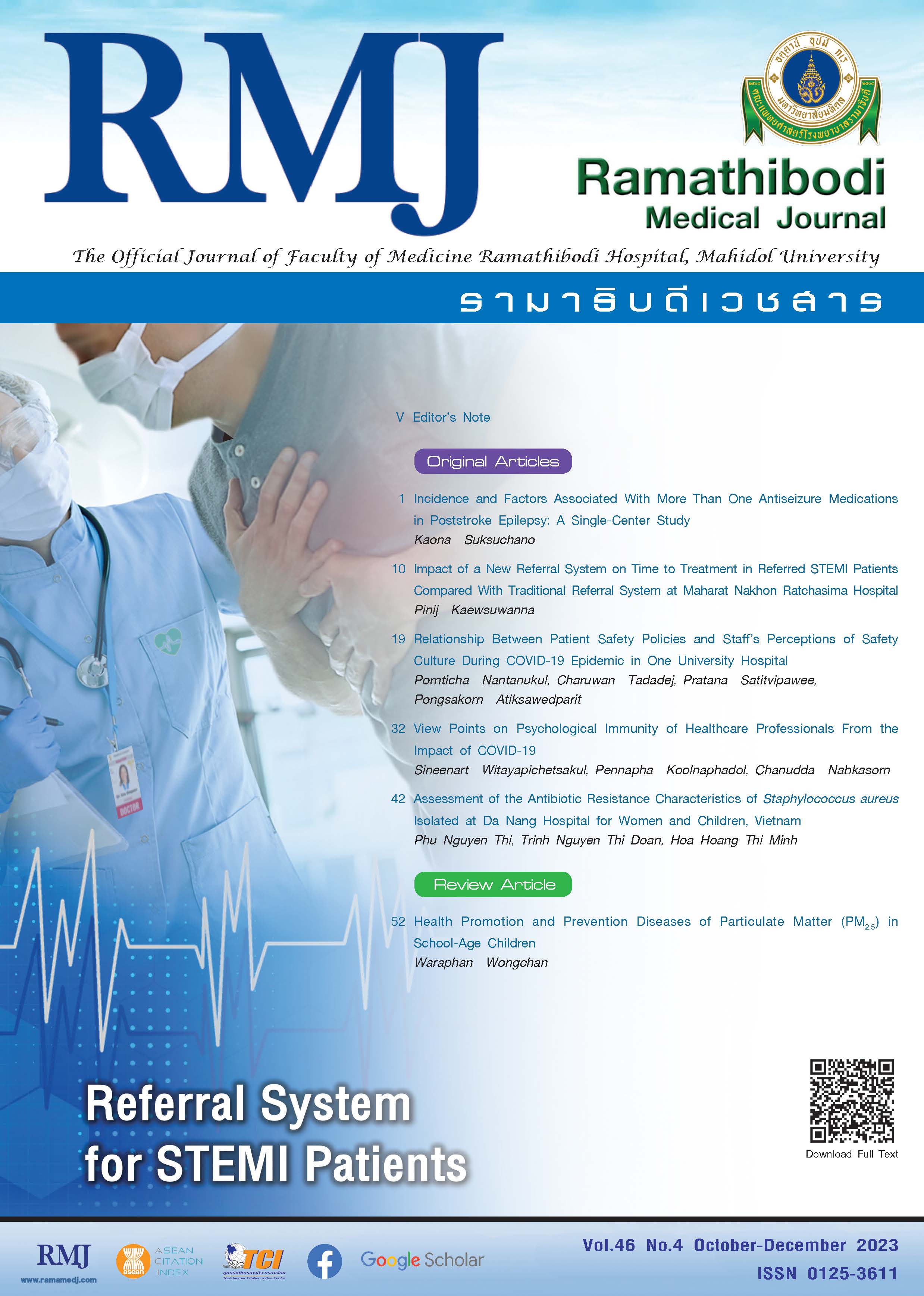Impact of a New Referral System on Time to Treatment in Referred STEMI Patients Compared With Traditional Referral System at Maharat Nakhon Ratchasima Hospital
DOI:
https://doi.org/10.33165/rmj.2023.46.4.265319Keywords:
STEMI, Referral system, Time delay to reperfusionAbstract
Background: Acute ST-segment elevation myocardial infarction (STEMI) is an emergency condition with a high risk of death if not promptly treated with a reperfusion strategy. Delayed transfer of STEMI patients to the catheterization room is associated with poor outcomes and high mortality. The data recording and transmission system is an important factor that may help shorten the time to access treatment.
Objective: To compare the time to reperfusion between 2 referral systems, the time-oriented transfer system with the traditional referral system.
Methods: The retrospective study of confirmed STEMI patients within 2 distinct timeframes: May 1, 2019, to March 31, 2020, for the traditional referral system; and May 1, 2022, to March 31, 2023, for the time-oriented referral system. Patients between April 1, 2020, and April 30, 2022, were excluded due to the COVID-19 pandemic outbreak.
Results: There were 330 (42.4%) patients referred through the traditional referral system, and 449 (57.6%) patients referred through the time-oriented referral system. Patients in both referral systems had comparable age and sex distributions. The Killip classification was also comparable. Patients in both referral systems were transferred from the community hospitals within comparable distance. The proportion of timely reperfusion was higher, and time to reperfusion were shorter than traditional referral system with statistically significant (median [IQR], 245 [160 - 340] and 203 [129 - 353] minutes, P < .05).
Conclusions: The new referral system can reduce total ischemic and reperfusion time.
References
GUSTO investigators. An international randomized trial comparing four thrombolytic strategies for acute myocardial infarction. N Engl J Med. 1993;329(10):673-682. doi:10.1056/NEJM199309023291001
Keeley EC, Boura JA, Grines CL. Primary angioplasty versus intravenous thrombolytic therapy for acute myocardial infarction: a quantitative review of 23 randomised trials. Lancet. 2003;361(9351):13-20. doi:10.1016/S0140-6736(03)12113-7
Brodie BR, Hansen C, Stuckey TD, et al. Door-to-balloon time with primary percutaneous coronary intervention for acute myocardial infarction impacts late cardiac mortality in high-risk patients and patients presenting early after the onset of symptoms. J Am Coll Cardiol. 2006;47(2):289-295. doi:10.1016/j.jacc.2005.08.065
Sejersten M, Sillesen M, Hansen PR, et al. Effect on treatment delay of prehospital teletransmission of 12-lead electrocardiogram to a cardiologist for immediate triage and direct referral of patients with ST-segment elevation acute myocardial infarction to primary percutaneous coronary intervention. Am J Cardiol. 2008;101(7):941-946. doi:10.1016/j.amjcard.2007.11.038
Henry TD, Sharkey SW, Burke MN, et al. A regional system to provide timely access to percutaneous coronary intervention for ST-elevation myocardial infarction. Circulation. 2007;116(7):721-728. doi:10.1161/CIRCULATIONAHA.107.694141
O'Gara PT, Kushner FG, Ascheim DD, et al. 2013 ACCF/AHA guideline for the management of ST-elevation myocardial infarction: a report of the American College of Cardiology Foundation/American Heart Association Task Force on Practice Guidelines. J Am Coll Cardiol. 2013;61(4):e78-e140. doi:10.1016/j.jacc.2012.11.019
Neumann FJ, Sousa-Uva M, Ahlsson A, et al. 2018 ESC/EACTS Guidelines on myocardial revascularization. Eur Heart J. 2019;40(2):87-165. doi:10.1093/eurheartj/ehy394
Ma J, Dong X, Jin Y, Zheng ZJ. Health care quality improvement for ST-segment elevation myocardial infarction: a retrospective study based on propensity-score matching analysis. Int J Environ Res Public Health. 2021;18(11):6045. doi:10.3390/ijerph18116045
Cannon CP, Gibson CM, Lambrew CT, et al. Relationship of symptom-onset-to-balloon time and door-to-balloon time with mortality in patients undergoing angioplasty for acute myocardial infarction. JAMA. 2000;283(22):2941-2947. doi:10.1001/jama.283.22.2941
Terkelsen CJ, Sørensen JT, Maeng M, et al. System delay and mortality among patients with STEMI treated with primary percutaneous coronary intervention. JAMA. 2010;304(7):763-771. doi:10.1001/jama.2010.1139
Chen SJ, Lai KC, Shih FY, et al. Electronic referral system for transferred patients with acute myocardial infarction. J Med Sci Taiwan. 2015;35(6):248-253. doi:10.4103/1011-4564.173003
Nielsen PH, Terkelsen CJ, Nielsen TT, et al. System delay and timing of intervention in acute myocardial infarction (from the Danish Acute Myocardial Infarction-2 [DANAMI-2] trial). Am J Cardiol. 2011;108(6):776-781. doi:10.1016/j.amjcard.2011.05.007
Menees DS, Peterson ED, Wang Y, et al. Door-to-balloon time and mortality among patients undergoing primary PCI. N Engl J Med. 2013;369(10):901-909. doi:10.1056/nejmoa1208200
Wilson BH, Humphrey AD, Cedarholm JC, et al. Achieving sustainable first door-to-balloon times of 90 minutes for regional transfer ST-segment elevation myocardial infarction. JACC Cardiovasc Interv. 2013;6(10):1064-1071. doi:10.1016/j.jcin.2013.05.018
Park J, Choi KH, Lee JM, et al. Prognostic implications of door-to-balloon time and onset-to-door time on mortality in patients with ST-segment-elevation myocardial infarction treated with primary percutaneous coronary intervention. J Am Heart Assoc. 2019;8(9):e012188. doi:10.1161/JAHA.119.012188
Dharma S. Comparison of real-life systems of care for ST-segment elevation myocardial infarction. Glob Heart. 2020;15(1):66. doi:10.5334/gh.343
Downloads
Published
How to Cite
Issue
Section
License
Copyright (c) 2023 Ramathibodi Medical Journal

This work is licensed under a Creative Commons Attribution-NonCommercial-NoDerivatives 4.0 International License.

















